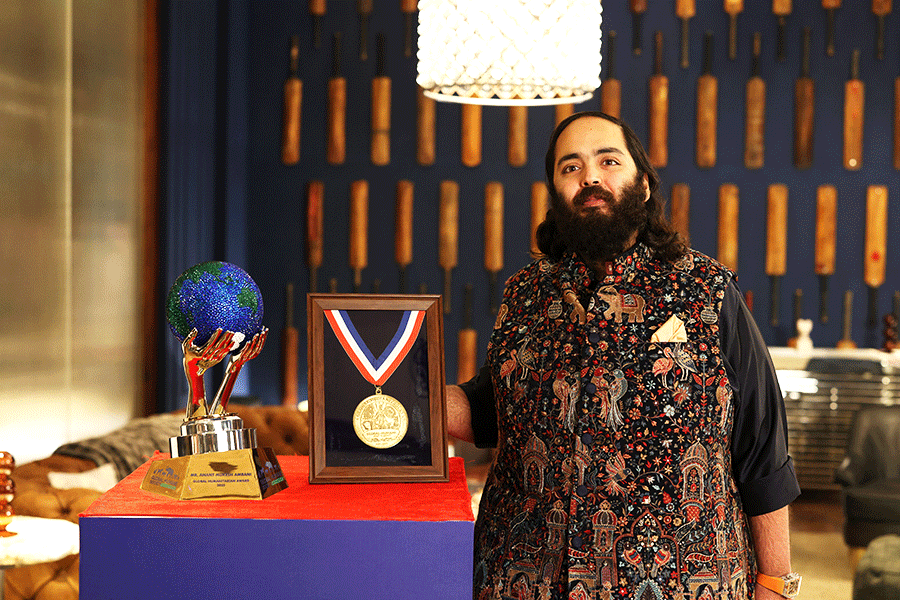-


Picture courtesy: Society for Preservation of Satyajit Ray Archives

Music and the men: Satyajit Ray (above) had made a series of rough sketches (top) for a film he had planned on Ravi Shankar (below)

On Satyajit Ray as a music director
Q: Satyajit Ray has been a family friend of yours since your childhood days. Can you tell us of the time when you first came to be associated with his films?
Ravi Shankar: When Satyajit Ray approached me to compose music for his film Pather Panchali, I agreed because we had been good friends for many years. Then when I saw the rushes of Pather Panchali, I was so moved emotionally. It touched a responsive chord in me, and I composed and had the music ready in exactly four-and-a-half hours... The rushes told me that it was a great picture. There is a spontaneity about it which none of his other films have quite achieved. Every element of the film has merged so perfectly to form a cohesive whole.
Q:What do you think of Ray as a music director?
Ravi Shankar: He is competent. He knows what he wants. He has experience in Western music, especially the piano.
Q: Do you think a good director can function as a good music director also?
Ravi Shankar: The only person who has been good in both has been, to my knowledge, Charles Chaplin. His music in Limelight was superb. And yes the person one could also mention is Noel Coward.
Q:What do you think of music directors as they function in India?
Ravi Shankar: It is difficult to say. It differs from music director to music director. Even the sound of the motor horn, chirping of birds, the lizard, and sometimes utter silence is more eloquent than any instrument, orchestra or sound. Today, film music is written in the name of classical music. Classical music is exploited to provide a veneer for popular tastes. For instance, Bade Ghulam Ali Khan's voice was used for Tansen's role in Mughal-e-Azam, and it is wrong. His style of singing is not that of Tansen's. There are many instances like this.
Courtesy: Montage, Special No. 5-6 on Satyajit Ray, July 1966
Working with Ray
Pather Panchali was not the first film for which I composed music. I had done it for Khwaja Ahmad Abbas's Dharti Ke Lal and Chetan Anand's Neecha Nagar which preceded Pather Panchali. I also had the experience of doing music for orchestra and thematic ballet.
When I watched the rough cut of Pather Panchali, I was moved beyond words. I worked for the film in an inspired state of mind. I still cherish that remarkable experience. Pather Panchali, Bibhuti Bhushan's novel, and Aparajito, its sequel, had been serialised in leading Bengali periodicals before they came out in book form. I heard my elders discuss them at home.
So I developed an interest in these novels at a tender, pre-adolescent age. The bamboo groves and mud trails of the Bengal countryside came alive before my eyes as I read them. Bibhuti Bhushan played the most moving tune with his pen in these novels. I felt a reawakening of that tune in me while viewing the rushes of Pather Panchali.
Satyajit-babu requested me to compose music for Pather Panchali when we met at Jnanprakash Ghosh's house in Kolkata's Dixon Lane. I accepted the offer immediately. Arrangements were then hurriedly made for the viewing of the rushes at Bhavani cinema. The time for recording was fixed too. The scoring of music for Pather Panchali was done in a day. I could finish my work in such a short time because Satyajit-babu had discussed the main theme of the film with me in clear terms. I think I am able to catch the inner spirit of a certain incident or sight and then express it through music. So my mind moved musically as I watched the silent movie in the darkness of the theatre. Music was created spontaneously. As I was humming to myself, the piece that was to be the theme music of Pather Panchali came to me.
As soon as it happened, I cried out, 'I've got it!' I didn't have to put in any extra effort for the job. I must acknowledge that I was fortunate to have brilliant musicians to work with during the music recording for Pather Panchali. They made my task much easier...
I used the tar shehnai instead of the violin or the sarangi for the scene of grief that followed Durga's death. The violin and the sarangi are less sharp than the tar shehnai. This instrument has the power to produce notes that are so poignant that they can, literally, pierce one's heart.
I felt its use would move audiences to tears by helping them empathise with Durga's grieving parents. That I was right to choose the tar shehnai was borne out by the fact that the music brought tears to the eyes of people from all countries and nationalities who came to see the film, transcending geographical and linguistic barriers...
I had no opportunity to be present at the time of editing any of the Ray films I had worked for. It was not possible because I was then in a 'hit-and-run' situation. I had a hectic schedule, travelling always from one place to another. I saw the films later and realised how admirably Satyajit-babu had used my music for the Apu Trilogy.
Satyajit-babu must have spotted some gaps in the music of Pather Panchali at the finishing stages. I was not close at hand. So he had to produce some additional musical effects to plug the gaps. Take, for example, the scene which shows a sweetmeat peddler going round the village to sell sweets. The scene demanded background music. So Satyajit-babu had his photographer Subrata Mitra play a beautiful piece on the sitar to fill the gap.
Satyajit-babu never tried to impose his ideas of music on me. He was not a person who would overreact and cramp the style of his music director. We only discussed the themes of the films. Sometimes he told me the kind of music he would prefer for a particular scene, but that happened only on a few occasions. I worked in my own natural style.
I've always been a great admirer of Satyajit Ray. But it beats me why critics hesitate to acknowledge my contribution to the music of Pather Panchali. However, Satyajit Ray himself never failed to recognise my contributions, which is why he trusted me to score music for three more of his films (Aparajito, Paras Pathar and Apur Sansar). That he did so was eloquent testimony to his unstinted appreciation of my music.
There are people who were surprised to see Satyajit-babu take over the task of providing music for his own films after Apur Sansar. The reason is not far to seek. A director's mind is like the mind of a mother who is never fully happy to leave the work of looking after her child to someone else. She would always want to care for her child herself if she has the time, or feels equal to it. That is why Satyajit-babu worked as music director for all his films since Teen Kanya.
But he never belittled others' accomplishments because he was an artist in the true sense of the word. Satyajit-babu was a man of refined sensibilities. He had a profound understanding of music. I do not wish to discuss the music of his longer films right now. Let's take up Pikoo, a short film he made in 1980. The musical treatment he gave this film within the twenty-six minutes of its space was simply incomparable! The flute tune he used for Pikoo is still etched in my memory. It was so simple yet so powerful! You cannot forget it because of its simplicity. It appeals immediately to your heart because it is so powerful!
This is what the music of Satyajit Ray is like.
From Atanu Chakrabarty's interview with Ravi Shankar, published in Mookhomookhi Ravi Shankar. Translated from Bengali by Arup K. De










